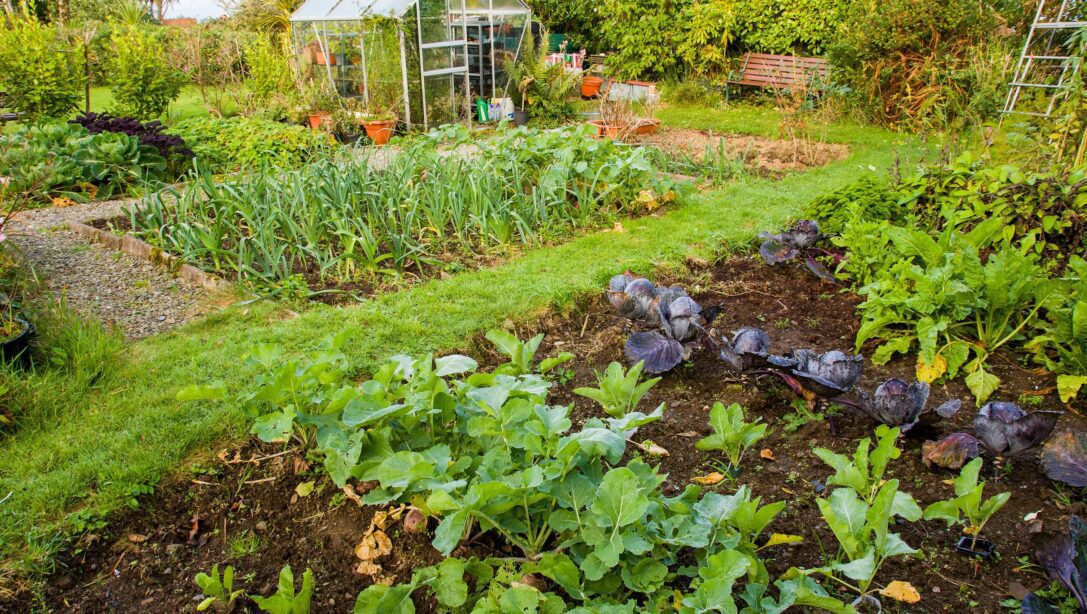Steve Harrison, Plant Area Manager at Hillier Garden Centre Newbury, is an expert in growing and caring for plants. But this year, a kindly neighbour has given him a piece of allotment and for the first time he is turning his hands to allotmenteering. In the second instalment, he continues growing and sowing and tackles the unseasonably cold April weather.
No.2 Braving the Cold | April 2021
“At the allotment, there have been a lot of changes since my first blog in March. The other ‘plotters’ are all very busy, with their various preparations underway. One thing that has been quite noticeable is that there is not a new piece of material to be seen. It was enjoyable to view, from the usual teepees for climbing beans to what looks like army climbing frames for beans, to ‘get set go’ growing up. Many mounds of soil have appeared, presumably covering buried potatoes, chitted ready to grow, with the green shoots paving the way for lovely new potatoes.”
Adjusting for the Cold
“With all the cold weather we have been experiencing this April, the beans I planted last month have grown well almost too well. For the last week or so they have been sitting on the windowsill, eager to venture onto the allotment for their final home. So far they have only made it as far as the patio during the daytime and back inside during the chilly nights. At last, as the month comes to an end, they are in their final spot, watered in and starting to grow.”
Seeds vs Plants
“There has always been a balance between plants you grow from seed with your own hard work, those I now discover that you swap with other ‘plotters’ around, and ones you buy in strips, cells or pots. I find it tempting to buy the larger plants from the garden centre – after all they surround me for many hours a day! And, there is such a huge range of plants in every style and colour, all grown ready to grow on then plant out. The ranges are so more comprehensive than even a few years ago.
“So, yes, I have purchased a few additions for the plot! I’ve got some lovely red-stemmed spring onions in cells and celery, as I thought it would be quite hard to germinate from seed. Plus, I just needed them for what I had in mind at the weekend …”
Planting and Protecting
“After a very cold start to the month, a good few evenings of not too cold weather finally emerged in mid April. I headed off to the plot with a wheelbarrow full of goodies – both home-grown from seed and bought as small plants.”
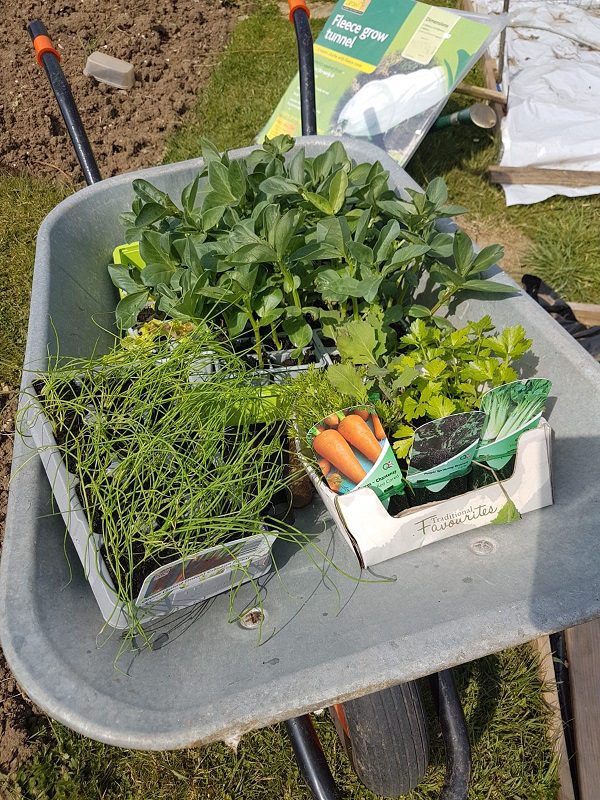
“I really noticed the difference in the soil in my beds when I took the polythene off I placed down to warm it up. The soil was much lighter, drier and fluffier for planting my broad beans in compared to the soil where I planting the purple sprouting broccoli last month without warming first. That had been a bit heavier and a little harder to make the holes.”
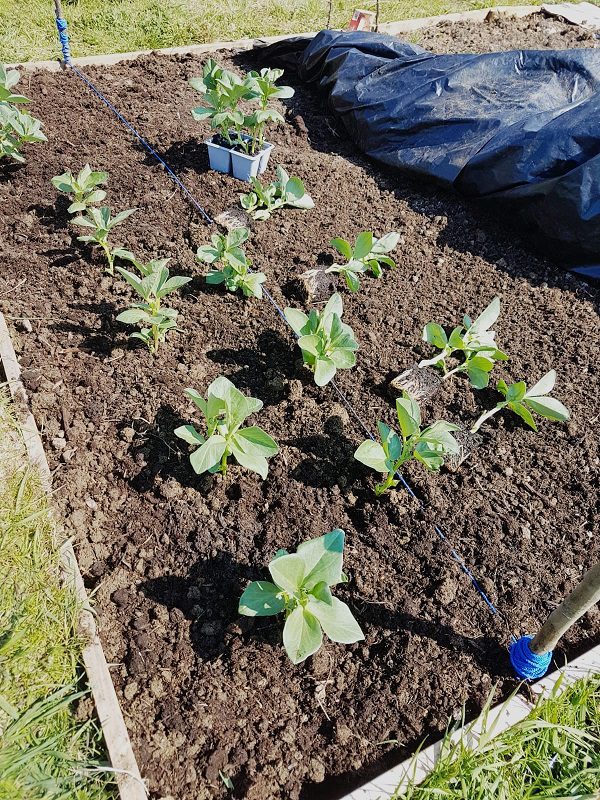
“Having planted my broad beans, I was about to put a collar around the base of my broccoli when I noticed the experienced ‘plotter’ next to me was using fleece to cover and some bird protection instead. I changed my mind and covered my broccoli with a fleece tunnel instead, which combines the bird protection along with keeping the plants warmer for a little longer. The homemade collars will have to wait for a later date.”
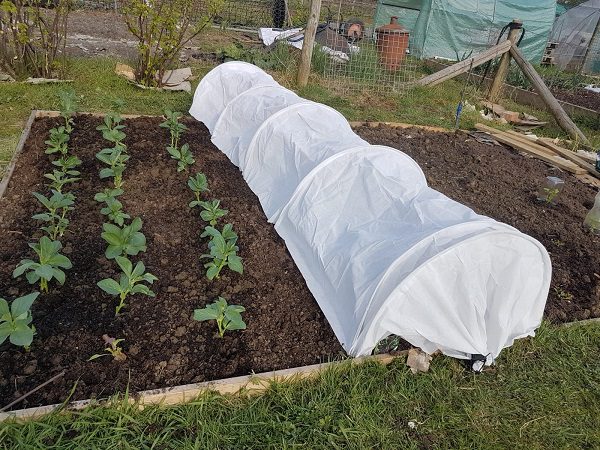
“I also gave some love to my celery with weather protection in the form of their very own ‘greenhouse.’ In this case, a greenhouse meaning the tried and tested tradition of re-using a plastic bottle with the base discarded.”
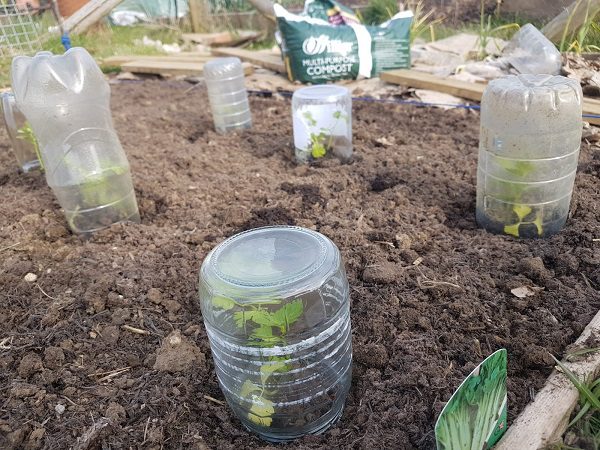
A Note on No Dig Weeding
“You may remember, that my allotment is in the ‘no-dig’ style, following the lead of my neighbour who gifted it to me. When you first start your plot, if there are a significant amount of weeds, to keep within no-dig principles you just cover the areas you want to cultivate with a layer of cardboard. Initially, this looks untidy. But, the aim is to block out the light getting to the weeds so they still grow but run out of energy fade from a dark green colour through shades of yellow to white and die. This is far more effective than digging them up and leaving parts of their roots in the ground to grow again. Also, the cardboard starts to degrade and mixes into the soil. If the weeds have not totally died by this point you just add more cardboard.
“Later on, this does lead to a greater reduction of perennial weeds that you have to cope with. You will always have some weeds that have blown in but the weeding, so I’m led to believe will be much less, and I’m all for that.”
Happy planting.
Steve from Hillier Garden Centre Newbury


